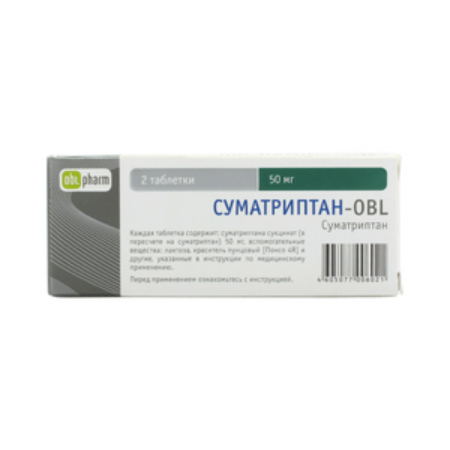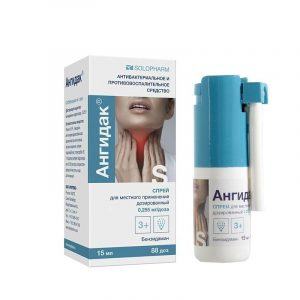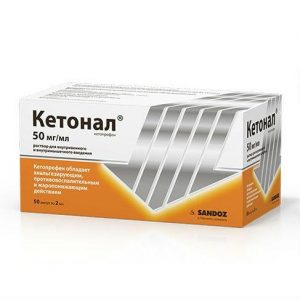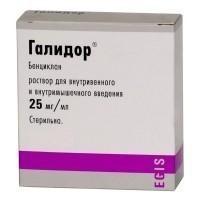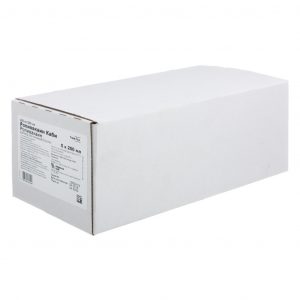Description
Latin name
SUMATRIPTAN
Packing
2 pcs – blister packagings (1) – packs of cardboard.
Indications
Migraine (for relieving seizures, with or without an aura).
Contraindications
Hypersensitivity to any component of the drug.
Hemiplegic, basilar and ophthalmoplegic forms of migraine.
Coronary heart disease (CHD) (including myocardial infarction, post-infarction cardiosclerosis, Prinzmetal angina), as well as the presence of symptoms suggesting the presence of CHD.
Occlusive peripheral vascular disease.
Stroke or transient ischemic attack (including history).
Uncontrolled hypertension.
Reception at the same time as ergotamine or its derivatives (including methysergide).
Use of monoamine oxidase inhibitors (MAOs) or earlier than 2 weeks after discontinuation of these drugs.
Severe impairment of liver and / or kidney function.
Age 18 and over 65 (safety and efficacy of sumatriptan not established).
Pregnancy and lactation.
Caution:
controlled arterial hypertension
diseases in which absorption, metabolism, or excretion of this drug (for example, impaired renal or hepatic function)
epilepsy (including any condition with a decreased seizure threshold)
in patients with hypersensitivity to sulfanilamides (administration of sumatriptan can cause allergic reactions, the severity of which varies from skin manifestations to anaphylaxis. Data on cross sensitivity are limited, dnako caution when assigning sumatriptan in these patients).
Use during pregnancy and lactation
Contraindicated during pregnancy and during breastfeeding (breastfeeding is possible no earlier than 24 hours after taking the drug).
Composition
Each film-coated tablet contains sumatriptan succinate 70 mg or 140 mg (in terms of sumatriptan 50 mg and 100 mg).
Excipients: lactose (milk sugar), calcium hydrogen phosphate (calcium phosphate disubstituted), magnesium stearate, povidone.
Coating aids: hypromellose (hydroxypropyl methylcellulose), copovidone (copolyvidone), polyethylene glycol 6000 (macrogol), talc, titanium dioxide, crimson dye [Ponso 4R].
Dosage and administration
Inside, the tablet should be swallowed whole with water.
Start treatment as soon as possible in case of a migraine attack. The recommended dose is 50 mg, if necessary 100 mg.
If the symptoms of migraine do not disappear and do not decrease after taking the first dose, then the drug is not used again to stop the same attack.
To stop subsequent seizures (if symptoms decrease or disappear, and then resume), you can take a second dose over the next 24 hours, provided that the interval between doses is at least 2 hours.
The maximum daily dose is 300 mg.
Side effects
The frequency of adverse reactions given below was determined according to the following: very often – more than 1/10 often – from more than 1/100 to less than 1/10 sometimes – from more than 1/1000 to less than 1/100 rarely – from more than 1/10 000 to less than 1/1000 is very rare – from less than 1/10 000, including individual cases.
From the nervous system: often – dizziness, drowsiness, sensitivity disorders, including parasthesia and decreased sensitivity.
From the cardiovascular system: often – a transient increase in blood pressure (observed shortly after taking the drug), “hot flashes.”
From the respiratory system and organs by a group of cells: often – dyspnea, lung, transient irritation of the mucous membrane or burning sensation in the nasal cavity or throat, nosebleeds.
From the gastrointestinal tract: often – nausea, vomiting.
From the musculoskeletal system and connective tissue: often – a feeling of heaviness (usually transient, can be intense and occur in any part of the body, including the chest and throat).
General and local reactions: often – pain, a feeling of cold or heat, a feeling of pressure or constriction (usually transient, can be intense and occur in any part of the body, including the chest and throat), weakness, fatigue (usually mild or moderate transient).
Laboratory indicators: very rarely – slight deviations in liver function tests.
Post-marketing surveillance of
The immune system: very rarely – hypersensitivity reactions, including skin manifestations, as well as anaphylaxis.
From the nervous system: very rarely – convulsive seizures (in some cases observed in patients with a history of convulsive seizures or in concomitant conditions predisposing to the occurrence of seizures in some patients, no risk factors were detected), tremor, dystonia, nystagmus, scotoma.
From the side of the organs of vision: very rarely – flickering, diplopia, decreased visual acuity, blindness (usually transient). However, visual disturbances can be caused by a migraine attack itself.
From the cardiovascular system: very rarely – bradycardia, tachycardia, flutter, arrhythmias, transient changes in the ECG, coronary vasospasm, angina pectoris, myocardial infarction, hypotension, Raynaud’s syndrome.
From the gastrointestinal tract: very rarely – ischemic colitis, dysphagia, a feeling of discomfort in the abdomen.
overdose
Symptoms: no adverse reactions other than those listed above are observed with up to 400 mg orally.
Treatment: gastric lavage, patient monitoring for 10 h, symptomatic therapy.
Storage conditions
Keep out of the reach of children. In a dry, dark place at a temperature of no higher than 25 ° C.
Expiration
2 years.
The active substance
Sumatriptan
dosage form
dosage form
tablets
Obolensky AF Russian
